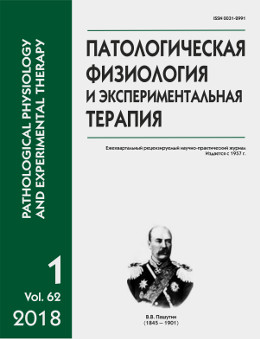The study of consequences of acute injuries by agents of pulmonotoxic action
Abstract
The purpose is to study features of an acute injury progression in case of poisoning by agents of pulmonotoxic action. Experimental work was done in a model of 160 white non-linear male rats weighing 180-220 g. For the assessment of an acute injury development after poisoning by agents of pulmonotoxic action the models of phosgene, nitrogen dioxide and paraquat poisoning were used. The assessment of gravimetric characteristics of lung tissue and changes of physical activity tolerance according to the rate of swimming duration to the full with 7%-load of body mass was carried out. The morphological assessment of severity of lung tissue injury was carried out as well. Results. It was found out that a single exposure of rats with pulmonotoxicants in 1LCt50 during its acute period was accompanied by the development of a range of morphological and functional changes which were typical for the course of toxic pulmonary edema. As a consequence of poisoning in a half of animals an evident decrease of functional abilities was observed. Pathologicoanatomic substrate of these abilities was the abnormality of lung parenchyma with destruction and bronchial tube and vessel fibrosis, that in 35% of cases matched with chronical purulent-destructive changes in lung tissue. Conclusion. The rate of consequences development after pulmonotoxic agents exposure was the following: 60% cases after paraquate exposure, 40% and 20% after phosgene and nitrogen dioxide respectively.
Downloads
References
2. Torkunov P.A., Shabanov P.D. The pathogenesis of toxic pulmonary edema. [Patogenez toksicheskogo oteka legkikh]. Saint Petersburg; Elbi-SPb; 2007. (in Russian)
3. Mikhno E.P. Dealing with the consequences of accidents and natural disasters. [Likvidatsiya posledstviy avariy i stihiynykh bedstviy]. Moscow; Atomizdat; 1979. (in Russian)
4. Pauluhn J., Carson A., Costa D.L., Gordon T., Kodavanti U., Last J.A. et al. Workshop summary: phosgene-induced pulmonary toxicity revisited: appraisal of early and late markers of pulmonary injury from animal models with emphasis on human significance. Inhalation toxicology. 2007; 19(10): 789-810.
5. Smith P., Heath D., Kay J.M. The pathogenesis and structure of paraquat-induced pulmonary fibrosis in rats. The Journal of pathology. 1974; 114(2): 57-67.
6. Ruzanova E.A., Drachkova I.M., Tolkach P.G. Comparative study of effectiveness of inhaled antioxidants andsodium cromoglycate in rat model of asphyxiant-indused acutelung injury. 2013. [Sravnitel'nyy analiz effektivnosti ingalyatsionnogo vvedeniya antioksidantov i kromoglikata natriya pri otravlenii krys pul'monotoksikantami]. Avaiable at: http://www.medline.ru/public/art/tom14/art23.html (Accessed 20 March 2013). (in Russian)
7. Holmes W.W., Keyser B.M., Paradiso D.C., Ray R., Andres D.K., Benton B.J. et al. Conceptual approaches for treatment of phosgene inhalation-induced lung injury. Toxicology letters. 2015; 224: 8-20.
8. Giri S.N., Hollinger M.A., Schiedt M.J. The effects of paraquat and superoxide dismutase on pulmonary vascular permeability and edema in mice. Archives of Environmental Health: An International Journal. 1981; 36(4): 149-54.
9. Dinis-Oliveira R.J., Duarte J.A., Sanchez-Navarro A., Remiao F., Bastos M.L., Carvalho F. Paraquat poisonings: mechanisms of lung toxicity, clinical features, and treatment. Critical reviews in toxicology. 2008; 38(1): 13-71.






